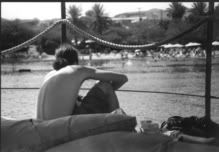Historians need 3D vision as well
So in this application from NASA you can basically (free of charge) browse the world in 3D, and take sattelite snaps. Then there are some scientific layers you can apply. But the most interesting for me is the 3D.
To be short now, my bottom line logic tells me 3D is more 'real' than 2D. So now humans can make pictures from space, why not do it? The first objection is: We are dealing with histories of countries. We stick to that perspective. This I think is stupid. For instance the fishercommunities around the North Sea, here in Holland, have throughout history formed a unified quasi-culture, while we describe most of history as "dutch". If the issues we research in World History are dealing with civilisations, we must re-allign some historical maps. Modernists are often claiming Nationalism is a modern thing, while anthropologists, historians of the middle ages and even micro-studies are convinced of "proto-nationalism".
Anyhow, to cut a long story short: Wouldnt it be nice to have an atlas be made filled with 3D-images of the earth, colored offcourse according to history, etc. etc...
In order for World History to work, students can use an atlas to develop different outlook. (critical or conventional)
Here are some of these samples
Here is one about Dutch Trade with Russia, and how exotic it can look in 3D:
http://img.photobucket.com/albums/v609/jonathanez/HandelvanuitdeRepubliek.png
3D snap of the Antique world, viewed from its centres. You notice Rome
is not that close, and dont forget Europe is just full of "barbaric
hoards".
http://img.photobucket.com/albums/v609/jonathanez/Waaromheethet_Outheid_.png
Compared to the previous picture this is the land of the "green people".
http://img.photobucket.com/albums/v609/jonathanez/HetGroeneland.png



 It was after the Gulf War that his mother and boyfriend at the time decided to 'descend' from the Holy land and set sail towards The Hague, being the birthplace of Even-Zohars
mother. Jonathan managed well in Grade school and High school, so the
next logical step was the University, the infinite source of knowledge.
After speculating on Industrial Design, Social Geography and Journalism
it was the study of History at Leiden that turned out to be his
decision.
It was after the Gulf War that his mother and boyfriend at the time decided to 'descend' from the Holy land and set sail towards The Hague, being the birthplace of Even-Zohars
mother. Jonathan managed well in Grade school and High school, so the
next logical step was the University, the infinite source of knowledge.
After speculating on Industrial Design, Social Geography and Journalism
it was the study of History at Leiden that turned out to be his
decision.
 Now, four years into the study, matters have only become more
complicated as this student advances towards World History; meaning the
complete array of fields a historian may implement in explaining the
entire past of the entire world to fellow men. It is especially the
philosophical character of World History that attracted Jonathan.
Now, four years into the study, matters have only become more
complicated as this student advances towards World History; meaning the
complete array of fields a historian may implement in explaining the
entire past of the entire world to fellow men. It is especially the
philosophical character of World History that attracted Jonathan.
 For him there is only one question that stands above all others like a
lonely chuchtower in some Flemish village, which asks the cause of the
Western Rise and the Industrial Revolution. Furthermore, the role of the
European self- and worldimage throughout its history may explain the
role of Europe in the Eurasian Human Web. Thus, the direct contact
between Islam and Christianity is to be investigated. Were Muslims
constantly on the verge of invading Europe? How did Arab people perceive
the 'barbaric' Christians? How was Science spread and how did the West
pick up knowledge form the Arabs or from further East? Europe and the
Islam are still not at peace, certainly not in the mind.
For him there is only one question that stands above all others like a
lonely chuchtower in some Flemish village, which asks the cause of the
Western Rise and the Industrial Revolution. Furthermore, the role of the
European self- and worldimage throughout its history may explain the
role of Europe in the Eurasian Human Web. Thus, the direct contact
between Islam and Christianity is to be investigated. Were Muslims
constantly on the verge of invading Europe? How did Arab people perceive
the 'barbaric' Christians? How was Science spread and how did the West
pick up knowledge form the Arabs or from further East? Europe and the
Islam are still not at peace, certainly not in the mind.
0 Comments:
Post a Comment
<< Home